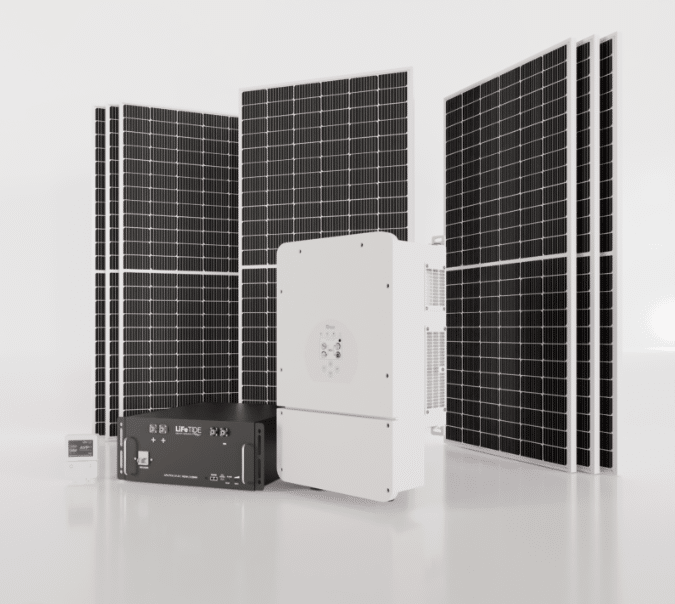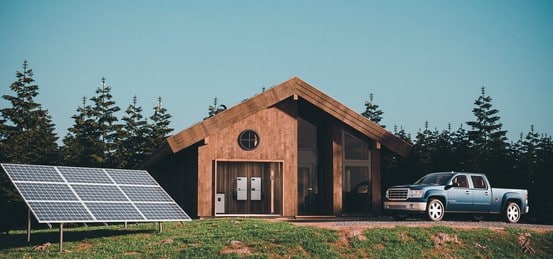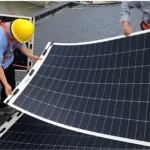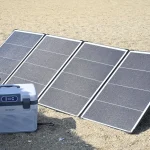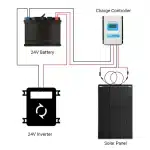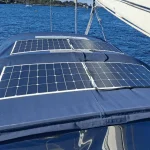Imagine living in a remote cabin or tiny home nestled deep within the wilderness, surrounded by breathtaking landscapes and untouched nature. This lifestyle allows you to disconnect from the busy world and enjoy the tranquility of living on a boat. As you wake up in your cozy cabin or tiny home to the sound of birds chirping, you’re filled with a sense of tranquility and self-sufficiency. This lifestyle offers a unique experience that deserves coverage. But how is it possible to enjoy such an off-grid lifestyle without relying on traditional power sources? By harnessing the power of solar panel kits, you can generate your own electricity and achieve a sustainable watt output. By harnessing the power of solar panel kits, you can generate your own electricity and achieve a sustainable watt output. That’s where off-grid solar system packages with batteries and charge controllers come into play, providing the necessary volt and panel setup for your cabin.
Off-grid solar systems, equipped with panel kits and a charge controller, are designed to power your home or cabin independently from the grid, promoting a sustainable lifestyle with clean and renewable energy. These solar panel systems, also known as kits, harness energy from the sun and use a charge controller to convert it into electricity. This electricity can be used for various purposes in a cabin or any other location where it is needed. What sets the solar panel kits apart is their integration with eg4 batteries and a charge controller. This allows for efficient energy storage in the solar power system.
Battery storage, including eg4 batteries, is essential in off-grid solar systems. It enables you to store surplus energy from the panel during the day for later use at night or on cloudy days. This is made possible with the help of a charge controller, which regulates the flow of energy between the panel and the battery case. This ensures a continuous power supply even when sunlight is scarce, making solar panel kits a necessity. With the use of eg4, you can rely on these kits to provide consistent energy. With advancements in technology, lithium batteries have become increasingly popular for solar power systems due to their high efficiency and longer lifespan compared to traditional lead-acid batteries. These batteries are commonly used in solar panel kits, such as the EG4.
Choosing an off-grid solar panel system kit offers numerous benefits, especially when considering the eg4 model. With a solar power system like the eg4 and solar panel kits, you can enjoy the freedom and independence to live anywhere you want, without being restricted by the lack of grid connectivity. These eg4 kits often include all the necessary components like solar panels, batteries, charge controllers, inverters, and wiring – making installation hassle-free.
In our next blog post, we will dive deeper into understanding different types of off-grid solar panel kits available in the market today, such as the eg4, and explore their features and advantages. So stay tuned!
Stay tuned for our next blog post where we will explore different types of off-grid solar panel kits, including the eg4, available in the market today!
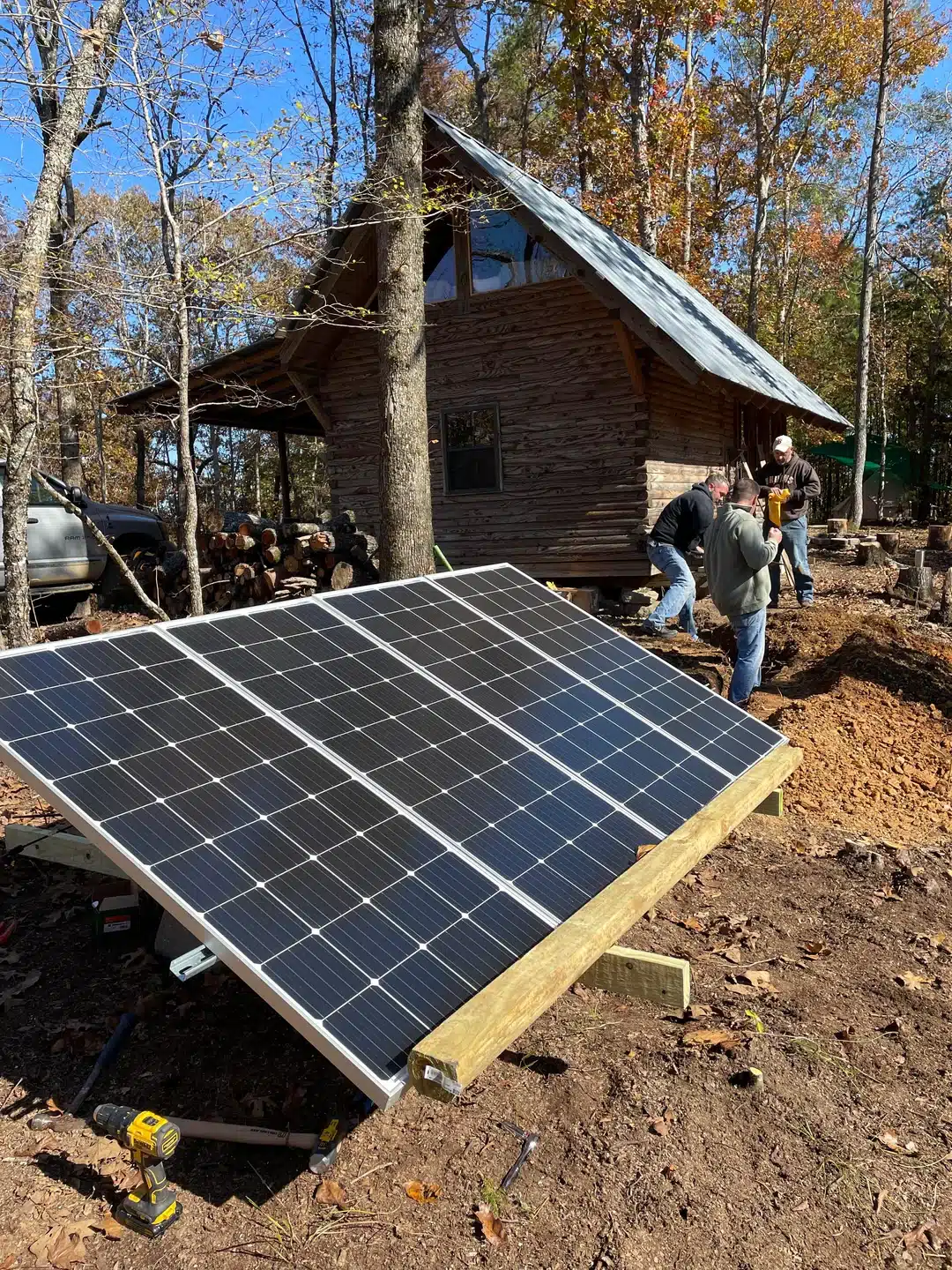
Benefits of Off-Grid Solar Systems in Remote Locations
Powering Up the Unreachable
Living in remote areas without access to the grid can be challenging, especially when it comes to powering your home. However, with the advancements in solar power systems and the availability of solar panel kits like the eg4, you now have a reliable and sustainable solution. However, off-grid solar panel kits with batteries offer a ray of hope for those residing in such locations, especially with the introduction of the new eg4 model. These solar panel kits provide a reliable and sustainable source of power, enabling people to light up their homes, charge their devices, and operate essential appliances.
Breaking Free from Fossil Fuels
One of the key advantages of off-grid solar systems is their ability to reduce reliance on fossil fuels for power generation. These systems utilize solar panel kits. These systems utilize solar panel kits. In remote locations where traditional energy sources may not be readily available or economically viable, solar energy panel kits become an attractive alternative. By harnessing solar power and converting it into electricity through photovoltaic panels, these solar power kits help minimize carbon emissions and contribute towards a cleaner environment.
Embracing Independence and Self-Sufficiency
Living off-grid often goes hand in hand with embracing independence and self-sufficiency. One way to achieve this is by installing a solar power system, such as solar panel kits. One way to achieve this is by installing a solar power system, such as solar panel kits. With off-grid solar panel systems, individuals can take control of their energy needs without relying on external providers. This newfound autonomy allows people in remote locations to become more self-reliant by generating their own power using solar panel kits. Solar panel kits empower individuals to live life on their terms while reducing dependence on centralized infrastructure.
Battling Power Outages and Unreliable Grid Connections
Power outages can wreak havoc on daily life, but they pose an even greater challenge in remote areas where grid connections are unreliable or nonexistent. In such cases, solar panel kits can provide a reliable source of power. In such cases, solar panel kits can provide a reliable source of power. Off-grid solar systems equipped with batteries and panels offer a practical solution to mitigate these issues. The solar panel kits batteries store excess energy generated during daylight hours, ensuring a continuous power supply even when the sun sets or during cloudy weather conditions. This resilience helps individuals overcome the disruptions caused by power outages or unreliable grid connections by using solar panel kits.
Off-grid solar panel system packages with batteries truly revolutionize living conditions in remote locations by providing much-needed electricity. Not only do solar panel kits offer a sustainable and clean source of power, but they also promote independence and self-sufficiency. By reducing reliance on fossil fuels, solar panel kits contribute to a greener future while combating the challenges posed by power outages or unreliable grid connections.
Imagine the possibilities when individuals living in remote areas can light up their homes, charge their smartphones, run essential appliances like refrigerators or water pumps, and even power small businesses with solar panel kits. Off-grid solar systems make all of this achievable. Solar panels enable people to break free from the shackles of limited access to electricity and embrace a more empowered way of life.
Moreover, off-grid solar panel systems are not just an environmentally friendly choice; they also make economic sense.
Factors to Consider when Choosing an Off-Grid Solar System Package
Determine your energy needs and load requirements
Before selecting an off-grid solar system package with batteries, it is essential to determine your energy needs and load requirements. One important factor to consider is the size of the solar panel panel. One important factor to consider is the size of the solar panel panel. Start by assessing the appliances and devices you plan to power using solar energy. Consider the wattage requirements of each device and calculate the total power needed for your panel. Consider the wattage requirements of each device and calculate the total power needed for your panel. Consider the wattage of the solar panels, their daily usage hours, and any peak power demands they may have. This will help you calculate the total energy consumption per day for your solar power system and solar panel.
For example, if you have a refrigerator that consumes 150 watts and runs for 24 hours a day, it would require 3.6 kilowatt-hours (kWh) of electricity per day (150 watts x 24 hours = 3,600 watt-hours or 3.6 kWh). This calculation is important when determining the energy needs for a solar power system and the appropriate size of solar panels. This calculation is important when determining the energy needs for a solar power system and the appropriate size of solar panels. Repeat this calculation for all your appliances, including your solar panel, to get an estimate of your daily energy consumption.
Consider any future expansions or changes in your energy needs, such as adding solar panels to your system. If you plan to add more appliances or increase usage in the future, it’s wise to account for those possibilities when choosing a solar system package.
Evaluate available sunlight and assess site suitability
The amount of sunlight available at your location plays a crucial role in the efficiency of an off-grid solar system. Assessing the site suitability for solar panel involves evaluating factors such as shading from trees or nearby buildings, roof orientation, and tilt angle.
To maximize the benefits of solar power generation, ensure that your chosen installation site receives ample direct sunlight throughout the day. A south-facing roof with minimal shading is generally ideal for optimal performance of solar panels.
If there are obstructions casting shadows over potential installation areas during peak sun hours, it can significantly impact the overall output of your solar panels. Take note of these factors before selecting a solar panel package to ensure maximum efficiency and effectiveness.
Consider battery capacity and lifespan
Battery capacity is another critical factor when choosing an off-grid solar system package with batteries. It determines how much solar panel energy can be stored for use during periods when sunlight is limited or unavailable. The battery capacity of your solar panel should align with your energy needs and provide enough power to sustain your load requirements during cloudy days or at night.
Consider the lifespan of the batteries as well. Different battery technologies, including those used in solar panels, have varying lifespans typically measured in cycles. A solar panel cycle refers to one full charge and discharge of the battery. When selecting a battery type for your long-term energy storage needs, it is crucial to consider the number of cycles offered by the solar panel.
Investing in batteries with longer lifespans can save you money in the long run, as they will require fewer replacements over time. Consider this aspect carefully, as it directly impacts the longevity and cost-effectiveness of your off-grid solar system.
Evaluating and Comparing Off-Grid Solar System Packages
Understanding the Different Components Included in Various Packages
It’s crucial to understand the different components included in each package. These components are essential for harnessing solar energy and storing it efficiently. Here are some key elements you should be aware of when evaluating and comparing these packages:
-
Solar Panels: The heart of any off-grid solar system is the solar panels, which convert sunlight into electricity. Look for high-quality panels that offer good efficiency ratings, as this will determine how much power you can generate.
-
Batteries: Since off-grid systems operate independently from the grid, batteries are necessary to store excess energy generated during the day for use at night or during cloudy periods. Consider the capacity and lifespan of the batteries offered in each package.
-
Charge Controllers: Charge controllers regulate the flow of electricity between your solar panels and batteries, preventing overcharging or damage to your battery bank. Look for advanced charge controllers with features like maximum power point tracking (MPPT) for optimal performance.
-
Inverters: Off-grid systems require inverters to convert DC power from your solar panels and batteries into AC power that can be used by household appliances. Choose inverters with sufficient capacity to meet your energy needs.
-
Mounting Equipment: Properly installing solar panels is crucial for maximizing their performance and longevity. Evaluate whether mounting equipment like racks, brackets, and hardware is included in each package.
-
Cables and Connectors: Reliable cables and connectors are essential for connecting all the components of an off-grid system securely. Ensure that high-quality cables with appropriate gauge sizes are provided in each package.
By understanding these different components, you can compare packages more effectively based on their suitability for your specific needs.
Comparing Warranties, Certifications, and Quality Standards Among Manufacturers
In evaluating off-grid solar system packages, it’s important to consider the warranties, certifications, and quality standards offered by manufacturers. These factors can provide valuable insights into the reliability and durability of the systems you are considering. Here’s what to look for:
-
Warranties: Check the warranty length provided for each component of the package, including solar panels, batteries, inverters, and other equipment. Longer warranties indicate that manufacturers have confidence in their products’ performance.
-
Certifications: Look for packages that include components with relevant certifications such as IEC (International Electrotechnical Commission) or UL (Underwriters Laboratories). These certifications ensure that the equipment meets specific safety and performance standards.
-
Customizing Off-Grid Solar Systems to Meet Energy Needs
Tailoring system size based on daily energy consumption patterns
One of the key factors to consider is tailoring the system size based on daily energy consumption patterns. Each household or business has unique energy needs, and it is essential to design a solar system that can meet those specific requirements.
To determine the right system size, it is crucial to assess the amount of energy needed on a daily basis. This involves analyzing past energy bills and understanding peak usage periods. By examining this data, you can identify trends and patterns in your energy consumption, allowing you to estimate how much power your off-grid solar system should generate.
For example, if your daily energy demand is high due to running multiple appliances simultaneously or operating heavy machinery, you may need a larger solar panel array and battery bank. On the other hand, if your lifestyle requires minimal electricity usage or if you plan to use alternative sources for certain tasks (such as gas-powered generators for heating), a smaller system may suffice.
Incorporating additional panels or batteries for increased capacity
In addition to tailoring the system size based on energy needs, another way to customize off-grid solar systems is by incorporating additional panels or batteries for increased capacity. This flexibility allows you to expand your system as your needs evolve over time.
Suppose you anticipate an increase in electricity demand due to future expansions in your household or business operations. In that case, it’s wise to invest in a solar setup that offers room for growth. By adding extra panels or batteries at a later stage, you can easily scale up your off-grid solar system without starting from scratch.
Moreover, incorporating additional equipment also enhances the overall performance and reliability of your off-grid solution. More panels mean more sunlight absorption and higher power generation potential. Similarly, increasing battery capacity provides greater storage capabilities during times when sunlight is limited, such as cloudy days or during the night.
Integrating backup generators or hybrid solutions for extended autonomy
To ensure extended autonomy and uninterrupted power supply, integrating backup generators or hybrid solutions into off-grid solar systems is a viable option. While solar energy is abundant and sustainable, there may be situations where additional power sources are necessary to meet energy needs consistently.
Backup generators can serve as reliable alternatives when sunlight is scarce for an extended period or during unforeseen circumstances such as severe weather conditions. By incorporating a backup generator into your off-grid solar system, you can have peace of mind knowing that you have a backup plan to rely on when needed.
Hybrid solutions combine the benefits of both solar energy and traditional grid connections.
Understanding the Components of Off-Grid Solar Systems
Photovoltaic (PV) Panels: Harnessing the Power of the Sun
Let’s start our journey into understanding off-grid solar systems by familiarizing ourselves with the primary energy source – photovoltaic (PV) panels. These panels are responsible for capturing sunlight and converting it into usable electricity. They consist of multiple interconnected solar cells, which work together to generate direct current (DC) electricity.
The process begins when sunlight strikes the surface of the PV panels, causing electrons in the solar cells to become energized and create an electric current. This DC electricity is then transferred to other components within the system for storage and use.
Charge Controllers: Regulating Battery Charging Process
To ensure efficient charging and prevent overcharging or damage to batteries, charge controllers play a crucial role in off-grid solar systems. These devices regulate the flow of electricity from PV panels to batteries, ensuring that they receive an optimal charge.
Charge controllers monitor battery voltage levels and adjust charging parameters accordingly. They protect batteries from overcharging during periods of high sun exposure and prevent deep discharge during low sunlight conditions. By controlling the charging process, charge controllers extend battery life and maintain their performance over time.
Energy Storage: Exploring Battery Types for Off-Grid Systems
Energy storage is a vital component of off-grid solar systems as it allows users to have access to electricity even when there is no sunlight available. Two common types of batteries used in these systems are lead-acid batteries and lithium-ion batteries.
Lead-acid batteries have been widely used for many years due to their affordability and reliability. They are suitable for applications where cost-effectiveness is a priority but may require frequent maintenance.
On the other hand, lithium-ion batteries offer higher energy density, longer lifespan, and reduced maintenance requirements compared to lead-acid batteries. Although they come at a higher upfront cost, their superior performance makes them an attractive choice for off-grid solar systems.
Inverters: Converting DC Power to AC for Household Use
While PV panels generate DC electricity, most household appliances and electronics run on alternating current (AC). That’s where inverters come into play. These devices convert the DC power produced by the solar panels into AC power that can be used to operate various household appliances.
Inverters perform this conversion through a process known as inversion. They ensure that the AC output matches the required voltage and frequency standards, allowing seamless integration with existing electrical systems. In addition to converting power, some inverters also offer advanced features like grid-tie capability or battery backup functionality.
Cost Breakdown of Off-Grid Solar System Packages
Understanding the pricing structure of solar panels, batteries, and inverters
Let’s dive into the nitty-gritty of off-grid solar system packages and understand how the costs are broken down.You need to consider various components such as solar panels, batteries, and inverters. Each of these elements plays a crucial role in generating and storing clean energy for your off-grid needs.
Solar Panels: The cost of solar panels can vary depending on factors like brand, efficiency, and capacity. Generally, high-quality solar panels tend to be more expensive upfront but provide better performance and durability in the long run. It’s essential to choose panels that suit your energy requirements while keeping an eye on their price.
Batteries: Batteries are an integral part of off-grid systems as they store excess energy generated by the solar panels for use during periods when there is no sunlight available. The cost of batteries can vary based on their capacity (measured in kilowatt-hours), lifespan, and technology used (such as lithium-ion or lead-acid). While lithium-ion batteries are known for their higher upfront costs, they offer longer lifespans and better efficiency compared to traditional lead-acid batteries.
Inverters: Inverters play a vital role in converting the direct current (DC) electricity produced by solar panels into alternating current (AC) electricity that can be used by household appliances. The cost of inverters depends on factors like power output capacity, efficiency ratings, and additional features such as monitoring capabilities or grid-tie functionality.
Apart from these main components, it’s important not to overlook other necessary equipment when considering the overall cost breakdown. These may include mounting hardware for securing the solar panels, wiring materials for connecting all components together efficiently, and electrical safety devices like circuit breakers or surge protectors.
Factoring in installation costs, including mounting hardware and wiring
Installing an off-grid solar system involves more than just purchasing the components. You also need to factor in the installation costs associated with setting up the system correctly. These costs typically include labor charges for professional installation, which ensures that your solar panels are mounted securely and wiring is done safely.
Mounting hardware is essential to ensure that your solar panels are installed properly and can withstand various weather conditions. The cost of mounting hardware can vary depending on factors like roof type (pitched or flat), material (metal or composite), and the number of panels you intend to install. It’s crucial to choose high-quality mounting hardware to ensure the longevity and stability of your system.
Harnessing the Power of Off-Grid Solar Systems
Clean Energy Production with a Reduced Carbon Footprint
Are you tired of relying on traditional energy sources that harm the environment? With off-grid solar system packages, you can enjoy clean energy production while reducing your carbon footprint. By harnessing the power of solar panels, these systems generate electricity without emitting harmful greenhouse gases. Solar power systems utilize renewable energy sources, such as sunlight, to convert it into usable electricity for your home or business.
Imagine being able to power your daily activities without contributing to air pollution or climate change. Off-grid solar systems allow you to do just that. By investing in a solar power system with batteries, you can store excess energy generated during the day and use it during nighttime or cloudy days. This ensures a continuous supply of clean and sustainable energy for your needs.
Utilizing Renewable Energy Sources for a Sustainable Lifestyle
The transition towards renewable energy is essential for creating a sustainable lifestyle. Off-grid solar systems play a crucial role in utilizing renewable energy sources effectively. Solar panels absorb sunlight and convert it into electricity through photovoltaic cells. This process requires no fuel consumption and produces no harmful emissions.
By embracing off-grid solar systems, individuals and communities can reduce their dependence on fossil fuels and contribute to a greener future. These solar kits provide an opportunity to generate electricity from an abundant and free source – the sun! Not only does this reduce reliance on non-renewable resources, but it also helps lower utility bills in the long run.
Empowering Communities with Reliable Electricity Access
Access to reliable electricity is not universal worldwide, especially in remote areas or regions facing infrastructure challenges. Off-grid solar system packages with batteries have emerged as a solution to empower communities by providing them with access to reliable electricity.
In many developing countries, where grid systems may be unreliable or nonexistent, off-grid solar systems offer an alternative way for people to meet their energy needs. These solar kits can be installed in homes, schools, and healthcare facilities, ensuring that essential services are not hindered by a lack of electricity.
By embracing off-grid solar systems, communities gain energy independence and the ability to create sustainable livelihoods. They no longer have to rely on intermittent power supply or expensive fuel generators. Instead, they can harness the abundant energy from the sun to power their daily activities and improve their overall quality of life.
Promoting Energy Independence and Resilience in Challenging Environments
Off-grid solar systems provide an opportunity for individuals and businesses to achieve energy independence. By installing a solar power system with batteries, you become less reliant on the traditional grid infrastructure.
Considerations for Choosing the Right Home Solar System Kit or Sizing Solar Panel for Shed
Evaluating available roof space or land area for solar panel installation
So, you’re considering going off-grid and investing in a solar system package with batteries. One of the first things you need to consider is the available space on your roof or land for installing solar panels. After all, these panels need ample sunlight exposure to generate electricity efficiently.
Take a good look at your property and identify areas that receive maximum sunlight throughout the day. If you have limited roof space, you might want to explore ground-mounted options. This way, you can optimize the energy production by placing the panels in an area with optimal sun exposure.
When evaluating your available space, keep in mind any potential obstructions such as trees, neighboring buildings, or structures that cast shadows. These shading issues can significantly affect the performance of your solar panels by reducing their efficiency. It’s important to choose a location where your panels can soak up as much sunlight as possible without any hindrances.
Determining energy consumption patterns to size the system correctly
To ensure that your off-grid solar system meets your energy needs, it’s crucial to evaluate your household’s energy consumption patterns. Understanding how much electricity you use on a daily basis will help you determine the appropriate size of the solar system package with batteries.
Start by analyzing your monthly utility bills and identifying peak usage periods. Consider factors such as high-energy appliances like air conditioners, refrigerators, or electric heaters that may consume more power than others. By having a clear understanding of your energy requirements, you can select a system kit that matches your specific needs.
Remember that sizing your solar system correctly is essential not only for meeting current demands but also for future scalability. It’s always better to slightly oversize rather than undersize your system so that it can accommodate any potential increase in energy consumption down the road.
Assessing shading issues that may affect solar panel performance
Shading can be a significant challenge. Even a small amount of shade on just one panel can impact the overall performance of your entire system. Therefore, it’s crucial to assess any potential shading issues before installing your off-grid solar system.
Start by identifying any nearby objects that could cast shadows on your panels, such as trees, buildings, or chimneys. Consider their height and distance from the installation site. If you notice any obstructions that might cause shade during peak sunlight hours, it’s advisable to trim or remove them if possible.
In some cases, shading cannot be entirely avoided due to permanent structures or geographical limitations.
The Benefits of Off-Grid Solar Panel Kits in Remote Locations
In conclusion, off-grid solar panel kits with batteries offer a range of benefits for those living in remote locations. With these kits, you can enjoy the freedom and independence of generating your own electricity without relying on the grid. Not only does this provide a reliable power source, but it also allows you to reduce your carbon footprint and decrease your reliance on fossil fuels. Off-grid solar systems are flexible and customizable, allowing you to meet your unique energy needs.
If you’re ready to take the leap into off-grid living, now is the time to explore the options available and choose the right solar system package for your needs. Consider factors such as energy requirements, budget, and available space when making your decision. With the right kit in place, you can harness the power of the sun and enjoy sustainable energy wherever you may be.
FAQs
How much maintenance do off-grid solar systems require?
Off-grid solar systems generally require minimal maintenance. Regular cleaning of panels to remove dirt or debris is recommended to ensure optimal performance. Battery maintenance may involve checking electrolyte levels (if applicable) and ensuring proper ventilation in battery enclosures.
Can I expand my off-grid solar system in the future?
Yes! One of the advantages of off-grid solar systems is their scalability. You can start with a smaller system and add more panels or batteries as needed. Just make sure that your charge controller and inverter are capable of handling the additional capacity.
Are there any government incentives for installing an off-grid solar system?
Government incentives vary by country and region. It’s worth researching local regulations and incentives that may be available to support renewable energy installations such as off-grid solar systems. These incentives could include tax credits, grants, or rebates that can help offset some of the costs associated with installation.
How long do batteries typically last in an off-grid solar system?
The lifespan of batteries used in off-grid solar systems can vary depending on factors such as battery type, usage patterns, and maintenance. Generally, lead-acid batteries can last anywhere from 3 to 10 years, while lithium-ion batteries have a longer lifespan of around 10 to 15 years.
Can I use off-grid solar systems in areas with limited sunlight?
Off-grid solar systems can still be effective in areas with limited sunlight. However, it’s important to assess the available sunlight and adjust your system accordingly. This may involve installing additional panels or utilizing more efficient equipment to maximize energy production.


